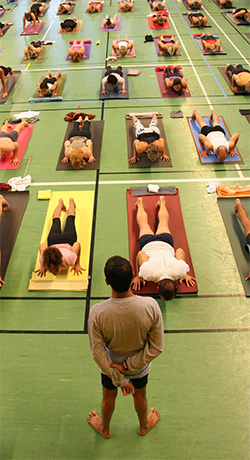 It’s been a month now since Sharath’s visit to London. I’ve finally got round to transcribing the first part of his Sunday conference. At the end of this talk there’s a Q & A session which is really interesting. Hopefully I’ll get round to transcribing the Q & A session at some point too. Just a note about the picture I’ve chosen. This was taken by Bill Brundell in August 2013 when Sharath was teaching in Stockholm.
It’s been a month now since Sharath’s visit to London. I’ve finally got round to transcribing the first part of his Sunday conference. At the end of this talk there’s a Q & A session which is really interesting. Hopefully I’ll get round to transcribing the Q & A session at some point too. Just a note about the picture I’ve chosen. This was taken by Bill Brundell in August 2013 when Sharath was teaching in Stockholm.
Sharath Sunday conference
Asana is just one limb of ashtanga yoga. It’s a very important limb. But asana is not itself the final stage of yoga. It is just the beginning. But everyone has to begin from somewhere.
You can’t get a degree in university without first going to school. Not everyone goes straight to samadhi. If you do a teacher training you won’t go to samadhi.
So it’s a process which should happen slowly. Through asanas we have to cleanse our body and mind. That is the purpose of doing asana. That is the purpose of asanas to purify the body and mind. While we are doing asanas we need to adopt yamas and niyamas. Yoga is for self-transformation. Patanjali says “chitta vritti nirodhah” (Patanaji’s Yoga Sutras 1:2) means to withdraw your sense organs to control your mind.
The process is to start with asana practice. Then you need to apply the yamas and niyamas, then the transformation starts happening in us. Once we put more understanding towards the yama and niyama.
Guruji always used to say: 99% practice 1% theory. Many people misunderstood this to mean that you should do asana all the time.
99% practice means that we should practice in our daily lives that means yama and niyama. All these things you should apply in your life. Don’t just keep talking, talking should be only 1%.
Only when we have a better understanding of the yamas and niyamas and practice, that becomes abhyasa. “abhyasa vairagyabhyam tat nirodhah” (Patanjali’s Yoga Sutras 1:12) Once we have a proper practice within us then it is possible to withdraw our sense organs.
When it comes to asana there are thousands of asana in this parampara. Krishnamacharya. In this lineage we have seen 600 – 1000 asana. This system is totally different from other yogas. There are many different states of yoga. When someone puts their surname next to yoga then there’s a new type of yoga.
There are many many asanas, why? These particular style of yoga is differnt than others. This is the traditional practice which has come from many generations. This system is called vinyasa system. Vinyasa means lots of movements in the postures and breathing techniques. Other yogas don’t talk so much about breathing, they just do the postures.
Why is vinyasa important. Vinyasa is used to purify the nervous system. Asana as I told you is the process to purify the body and mind. So this vinyasa process, by doing this we generate internal heat – which removes the toxins. Once the toxins are removed from the body the body becomes healthier. So by doing asanas it’s like a meditative practice and it gets deeper and deeper when you practice for a long time.
Then it becomes like a meditative practice so you can withdraw your mind, or control your mind slowly. I know many postures are difficult for you, whenever that posture comes you get fear. But practice “sa tu dirghakala nairantarya satkara adara asevito dridhabhumih” (Patanjali’s Yoga Sutras 1:14) – practice you can’t do two days in a week – start and then stop. it has to be “sa tu dirghakala” that means long time for many months/years. Nairantarya – continuously, with respect and gratitude. Then only you have a proper foundation. Once we have a proper foundation then we can go to higher levels of yoga.
So this vinyasa system can’t be understood in a few months, it takes years. The body has to change and the breathing technique you have to understand and by applying that when you do asanas. The process takes a long time to understand and practice.
So this is Krishnamacharya’s lineage which as come to us from now.

Thank you for sharing